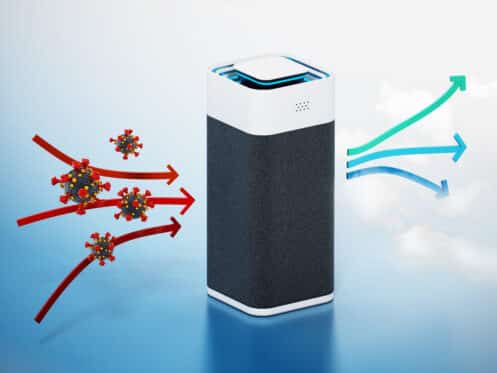Indoor air quality (IAQ) is a crucial aspect of our daily lives that we often take for granted. The quality of our indoor air directly affects our health, comfort, and overall well-being. No matter what time of year it is or what kind of weather is brewing outside, we spend a lot of our lives indoors. Our indoor air is just as susceptible to bacteria, pollution, and allergens as the air we breathe outside.
Allergens, pollutants, and microorganisms build up over time inside the home, which can result in sickness or allergic reactions. If you or someone in your home has particularly bad respiratory problems, this can be extra detrimental. Poor IAQ can significantly reduce your overall comfort and health if neglected.
Fortunately, there are several effective ways to improve the indoor air quality in your home! By implementing these strategies, you’ll be able to create a safer and more comfortable indoor environment that promotes better health and well-being for you and your loved ones. We’ll be covering the top 10 best ways to improve indoor air quality in your home so you can breathe easily!
Understanding Indoor Air Pollution
In order to combat poor indoor air quality, it’s essential to understand the causes. Sources of indoor air pollution can vary and originate from everyday occurrences to members of your household. This can include cleaning with harsh chemicals, letting dirt and dust accumulate, smoking indoors, having a lot of pets, neglecting your HVAC system, cooking, and excessive humidity – just to name a few.
- Pollen and dust mites
- Volatile organic compounds (VOCs)
- Mold and bacteria
- Tobacco smoke
- Pet dander
- Household chemicals
In less likely but still possible scenarios, your indoor air quality could be affected by radon gas seeping inside (a naturally occurring gas that comes up from the ground), asbestos and lead (from living in an older home), and sometimes even DIY projects that involve chemicals.
Some symptoms you may experience with poor IAQ can include irritation of the eyes, nose, and throat. Prolonged exposure to indoor pollutants can lead to respiratory problems, allergies, and, in extreme cases, heart and lung problems.
In any case, to prevent major and minor side effects of bad indoor air quality, here are some actions you can take.
#1 Regularly Ventilate Your Home
Proper ventilation plays a crucial role in ensuring that indoor air remains fresh and free from pollutants, allergens, and excess moisture. When a home is properly ventilated, indoor contaminants like volatile organic compounds (VOCs), odors, and allergens are significantly reduced while also regulating temperature and humidity levels.
So what can you do about this? First, make sure that your home has a good balance of natural and mechanical ventilation.
You can do this by using exhaust fans in kitchens and bathrooms to air out moisture and odors. Regularly clean and replace filters in heating, ventilation, and air conditioning (HVAC) systems to maintain their efficiency.
Open windows and doors when weather permits to let in fresh outdoor air. Consider the use of air purifiers to improve indoor air quality further.
Properly seal any gaps or cracks in the building envelope to prevent drafts and ensure that conditioned air is not lost unnecessarily.
#2 Invest in Air Purifiers
Whole-home air purifiers can be extremely helpful in addressing air quality concerns. High-efficiency particulate air (or HEPA) filters are great for removing particles like dust, pollen, and pet dander.
Activated carbon filters work at reducing odors from smoke and other volatile organic compounds (VOCs).
Additionally, ultraviolet (UV) air purifiers are used to neutralize viruses and bacteria, while ionic or electrostatic purifiers trap particles through electrical charges. However, these can be a little less eco-friendly than their counterparts, so it’s best to keep this in mind when choosing an air purifier type.
Once your air purification system has been set up, you’re bound to notice a difference in your overall air quality, especially if you’re sensitive to smells and allergens.
#3 Keep Your Home Clean
This may sound like an obvious solution, but it really helps!
Keeping every room of your house clean is one of the most significant ways you can enhance your indoor air quality. Things like pollutants, allergens, and contaminants like dust, pet dander, and mold can build up very quickly when cleaning is set aside. It’s essential to get on a regular schedule for dusting, vacuuming, and surface cleaning in order to remove these unwanted pollutants.
Using HEPA-equipped vacuum cleaners, regularly cleaning bedding and upholstery, and preventing mold growth will show a significant difference in air quality over time. Eco-friendly, low-VOC cleaning products are highly recommended. With proper ventilation (see number one), you can quickly expel airborne particles and fumes, making clean air easy to attain.
Establishing a cleaning schedule is a straightforward way to enhance indoor air quality that is beneficial in more ways than one. Regular cleaning is essential to maintaining a healthier indoor environment.
#4 Eliminate Tobacco Smoke
It’s no secret that smoking is unhealthy and has adverse effects when done inside the home rather than out. Smoking significantly reduces indoor air quality by releasing harmful chemicals, particulate matter, and secondhand smoke into the indoor environment. These pollutants can lead to respiratory problems, unpleasant odors, staining, and health risks for all members of the home. Establishing no-smoking zones and using ventilation and air purifiers can help mitigate the impact of smoking on indoor air quality.
- Establish a strict no-smoking policy inside your home
- Designate a smoking area outdoors, away from doors and windows
- Encourage smokers to quit or seek help to protect their own health and that of other residents
- Use HEPA filters and activated carbon filters to help remove smoke particles and odors
- Clean regularly to remove smoke residue from surfaces, walls, curtains, and upholstery.
- Use air sealing and proper ventilation to prevent smoke from infiltrating your living space
#5 Controlling Humidity Levels
Humidity levels can really make a difference when it comes to indoor air quality, affecting comfort and health. High humidity levels, unfortunately, become ground zero for mold, mildew, and dust mites, which can exacerbate allergies and respiratory issues.
However, extremely dry air results in general discomfort, dry skin, and, in some cases, respiratory problems. So, how do you manage to balance the humidity in your home?
Dehumidifiers and Humidifiers
These are great tools for improving your indoor air quality and balancing humidity.
Dehumidifiers help remove excess moisture from the air, reducing potential mold growth and making your living space more comforting.
Humidifiers have the opposite effect and add moisture to dry air. This can alleviate discomforting things like dry skin, cracked lips, and even asthma symptoms.
The best way to control the humidity levels in your home is to determine if you need more moisture or to remove excess, and then invest in a dehumidifier or humidifier.
#6 Using Natural and Non-Toxic Cleaning Products
Using non-toxic cleaning products will make all the difference for your indoor spaces. When you opt for more natural cleaning agents, you’re able to prevent harsh chemicals and fumes from infiltrating the air. Consistently cleaning surfaces, floors, and so on with harsh chemicals makes the air in your home consistently toxic. So, by choosing non-toxic cleaning products, you’re not only cleaning your space but also taking care of the air you and your family breathe.
- Vinegar and water solution
- Baking soda paste
- Lemon juice
- Castile soap
- Hydrogen peroxide
- Cornstarch
- Essential oils
- Citrus-based cleaners
- Olive oil for polishing
- Cloth rags and reusable cleaning cloths
#7 Maintaining Your HVAC System
Getting your system’s air filter swapped out every 1-3 months will contribute to enhancing the quality of your home’s indoor air. So, it’s essential to make this a part of your schedule.
Regular HVAC maintenance promotes efficiency, reliability, energy savings, and even a greener environment. Cleaning and replacing air filters are essential to improving indoor air quality and preventing excessive wear and tear on the HVAC unit. When you schedule HVAC inspections with professional technicians (Like those at AC by J), you’ll find that they go beyond just routine maintenance.
Changing out your filters, scheduling regular maintenance, and addressing issues before they get worse will keep your system at peak performance. And as a result, will improve your indoor air quality substantially.
#8 Bringing in Houseplants
Did you know that houseplants are like natural air purifiers? When you bring plants into the home, you’re not only enhancing the aesthetic of the room but contributing to the health of your IAQ!
Houseplants can absorb various pollutants, including VOCs and carbon dioxide. All while releasing oxygen into the environment.
- Snake plants (Sansevieria)
- Spider plants (Chlorophytum comosum)
- Peace lilies (Spathiphyllum)
- Boston ferns (Nephrolepis exaltata)
These plants can effectively remove common indoor pollutants such as formaldehyde, benzene, and xylene. They’re also just great additions to any living space!
#9 Allergen-Proofing
Knowing what allergens your indoor air quality is up against is half the battle. Allergen-proofing your home is going to make a big difference for you and the rest of your household. But what can you do to successfully allergen-proof your living space?
How To Allergen-Proof Your Home
A simple way to begin is through regular cleaning and vacuuming. You can also use allergen-proof covers on mattresses and pillows – to prevent them from being covered in pet dander, pollen, and so on. If someone in the house has pet allergies, you can designate their room to be a pet-free zone!
Next, you’ll want to maintain proper humidity levels to prevent mold growth. As previously mentioned, investing in a humidifier can help with this.
Ventilation and air purification also play a significant role in reducing indoor allergen levels. Purchasing an air purifier can make a noticeable difference.
The Benefits of Reducing Allergen Exposure
There are plenty of benefits to reducing your home’s allergen exposure. Whether or not you have someone in the home who suffers from allergies or asthma, allergen-proofing the home can alleviate allergy symptoms. This can include: sneezing, coughing, itching, and congestion. Some of which you may not even notice you have until you start to breathe better!
In addition to clearing up your sinuses, allergen-proofing can sometimes lower the risk of developing asthma and other respiratory conditions. It can promote better sleep and reduce your need for allergy medicine.
#10 Reducing VOCs
VOCs (or Volatile Organic Compounds) are organic chemicals that can easily evaporate into the air through both natural and human-made sources. They are released as gas through solids or liquids. They can be found in a wide range of products and materials, including:
- Paints
- Solvents
- Cleaning agents
- Adhesives
- Cosmetics
- Building materials like carpets and particleboard
To reduce your home’s exposure, try to choose low-VOC or VOC-free paints, varnishes, and cleaning supplies. You can opt for more natural cleaning solutions by using ingredients like vinegar, baking soda, and essential oils.
If you’re installing new flooring, consider hardwood, bamboo, or linoleum, which have fewer VOCs compared to other materials.
Keeping household chemicals like paints and solvents in tightly sealed containers and putting them away in a well-ventilated area like a garage or shed can also reduce exposure.
Other ways to reduce common VOCs can be found in the other ways to improve IAQ listed above.
Reach Out to AC by J for Help with IAQ
It’s important to recognize the long-term benefits that come from maintaining good indoor air quality. When your indoor air quality is taken seriously, you’ll start seeing improvements in health and comfort. The best ways to start noticing a difference and improving your home’s air is by keeping your household on a regular cleaning schedule, investing in an air purifier or humidifier, getting annual HVAC tune-ups, reducing or eliminating smoking in the home, creating areas that are pet-free zones, using all-natural cleaning products, choosing paints and solvents and other products with low VOCs, and making sure your home is properly ventilated.
For additional help with enhancing your home’s indoor air quality, such as HVAC maintenance, and IAQ inspections, reach out to our team at AC by J today!






